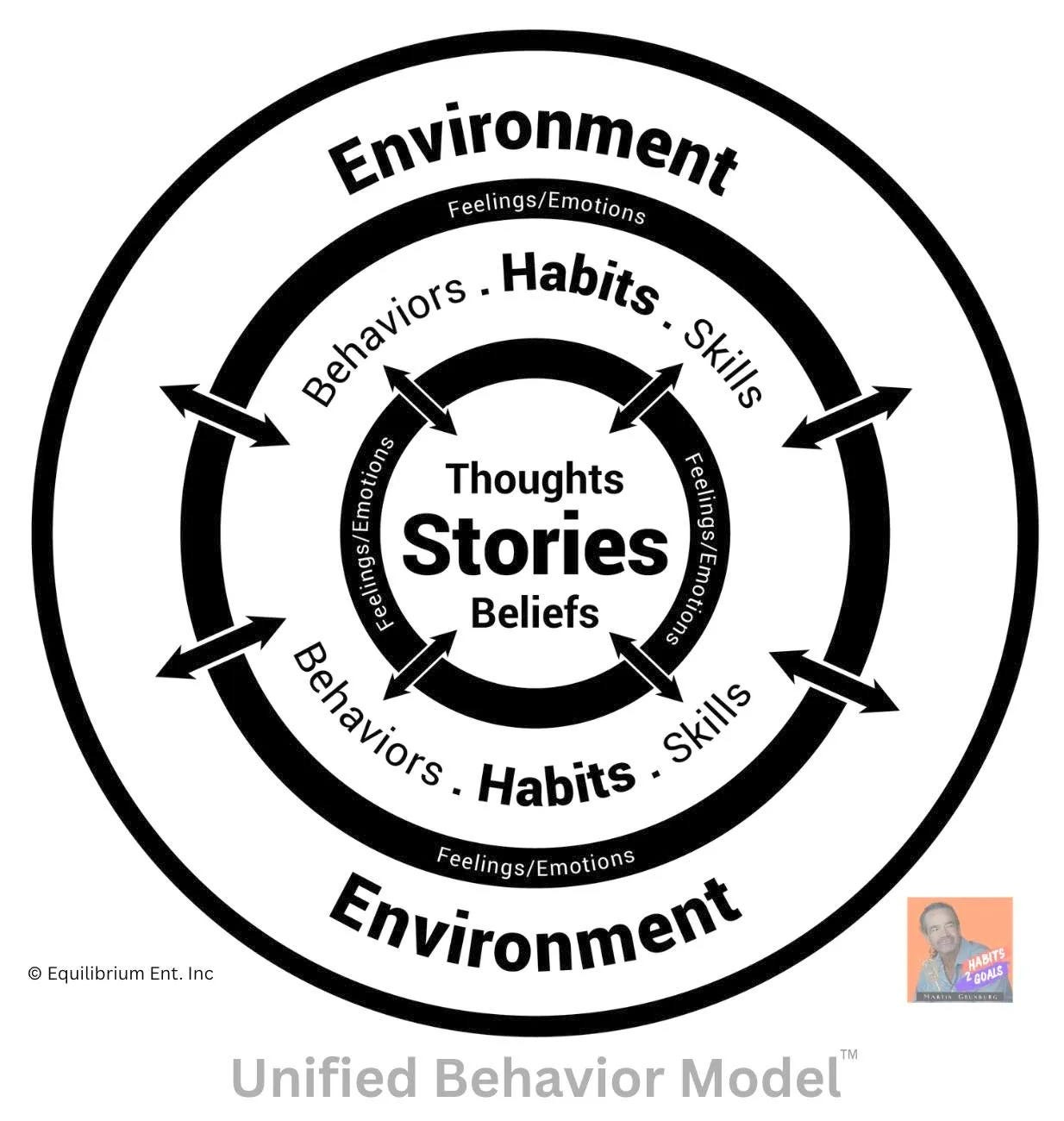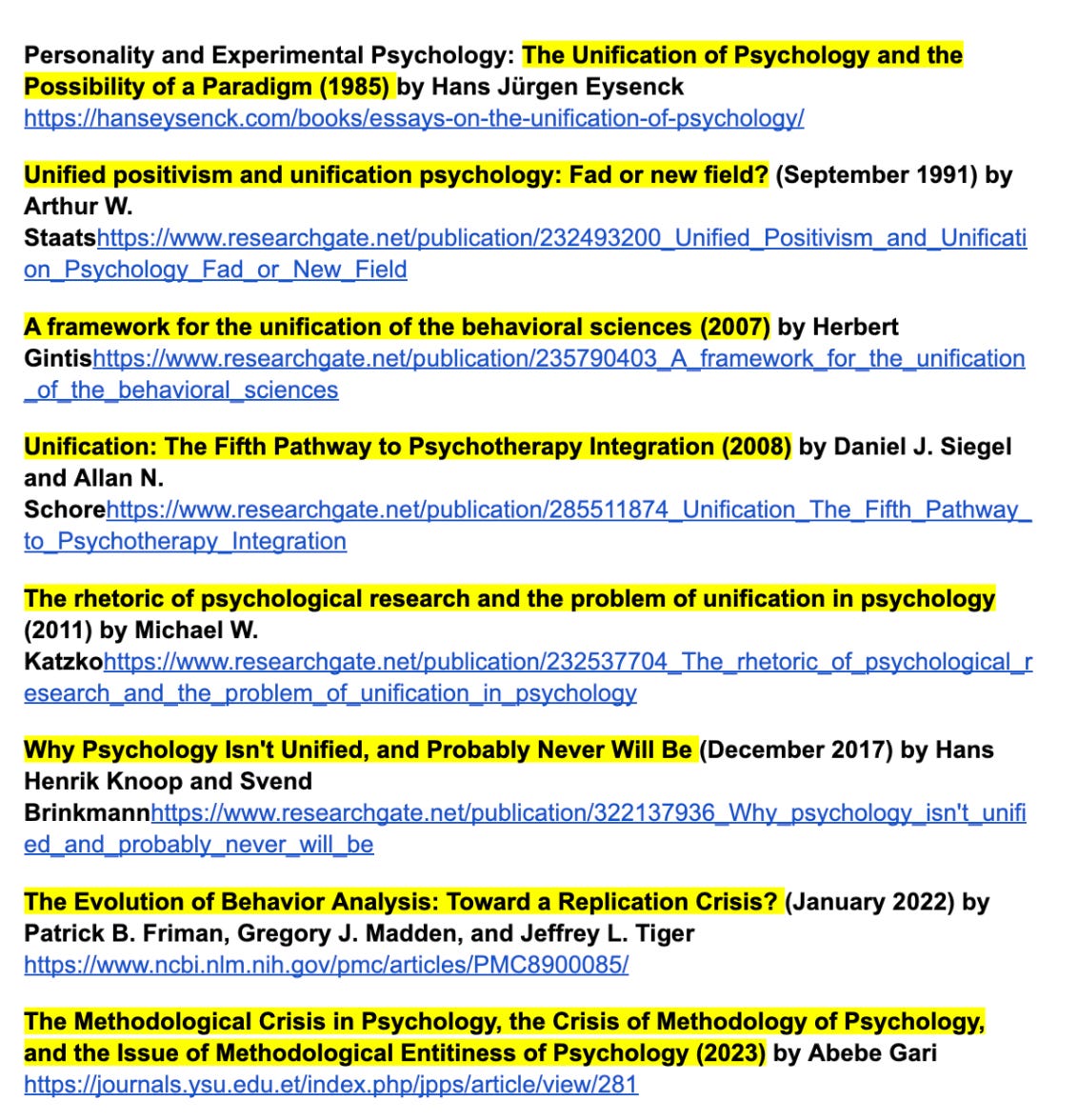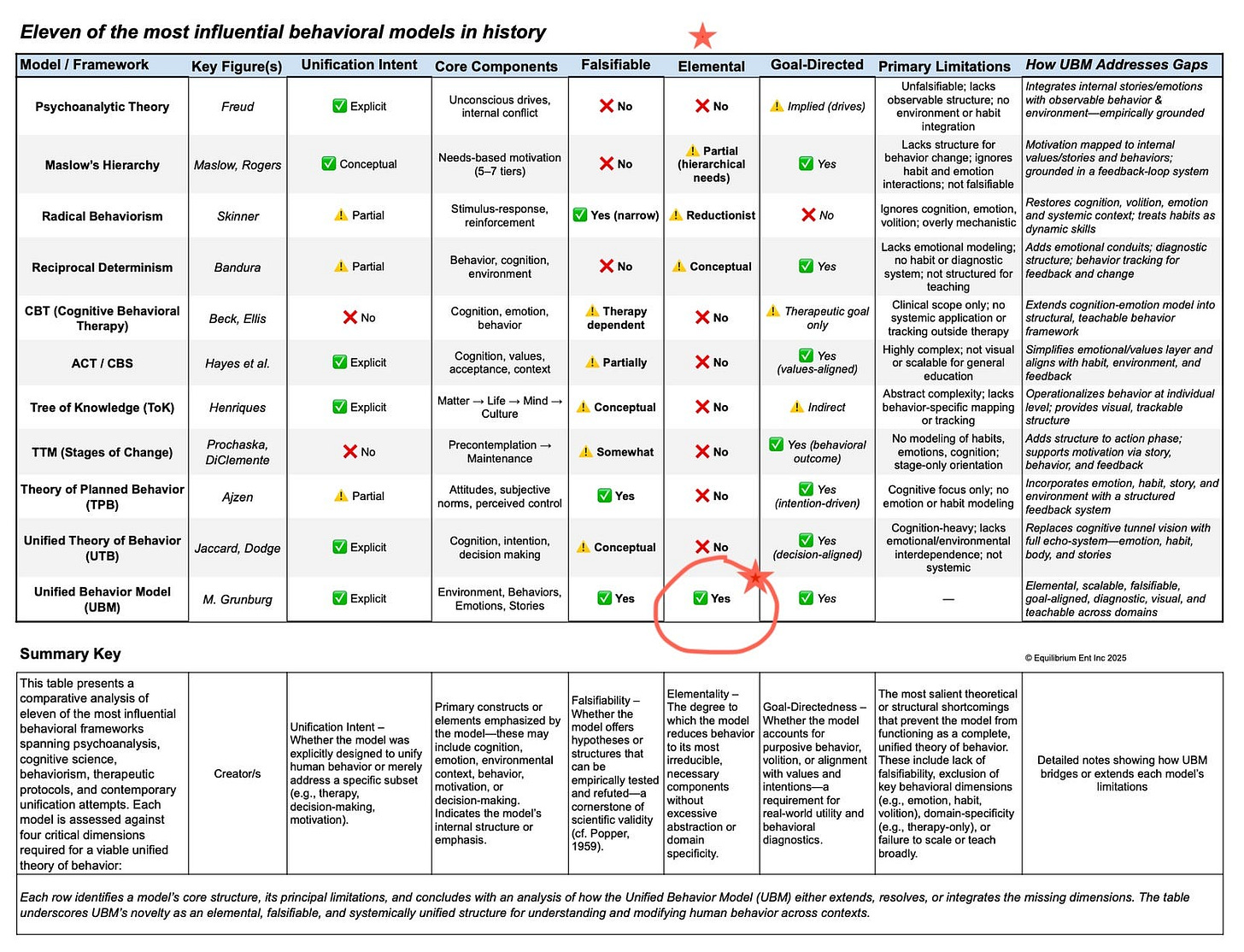Unified Behavior Model (UBM), Debated
OPEN SCIENCE: “Allegedly,” the only elemental and unified behavioral model.
On July 8th, in what can only be described as an act of reckless clarity, we published a white paper (grab it here →), Unified Behavioral Model
“Science is the art of systematic oversimplification.” ~Karl Popper
UBM simplifies on purpose, not by accident.
It maps ALL of human behavior (as never done before) into just four recursive domains:
- Environment (yes, your body counts — more in a sec)
- Cognition (thinking, beliefs, inner narratives/stories)
- Behaviors (habits, skills)
- Emotions & Feelings (signals, relays/conduits)
That’s it. That’s all.
No fifth element. No twelfth element.
And definitely not a 39th element.
There’s not even a magic mystery box.
There IS just one caveat: If you remove even one of the core four elements, the model breaks.
Go ahead, name just ONE thing that influences your behavior.
Now, hold that thought for a moment. 😉
And here’s what you’ll find: Anything you add becomes redundant — it either maps into one or more of the core four elements, or it’s an emergent property of them.
As mentioned before: Grit, greed, pain, pleasure, motivation, willpower, frustration, anger, consciousness, religion, heartbreak, hustle, TikTok addiction, any addiction, martyrdom, Black Friday stampedes, falling in love, walking away — ALL of it — ALL OF BEHAVIOR — either fits into one of those four core domains or emanates from them.
Scientifically, this is considered elemental sufficiency—think, first principles.
Smart fellows like Einstein, Popper, Feynman, Schrödinger, and Galileo advocate for its adherence.
“But wait… my body is part of the environment?”
Behaviorally speaking? You bet it is!
(To clarify: this is a behavior model, not a model of a person.)
Consider a toothache.
A behavioral stimulus — that may be just as disruptive (or worse) than bad cologne… or some joker heckling umpires at a baseball game.
They’re ALL “environmental” stimuli — external or internal — that may influence behavior.
Each one changes how you think, feel, and act.
That’s the Behavior Echo-System in action.
A dynamic, recursive system of behavior. Hence, “Echo–System” and not ecosystem.
Voilà. 👇🏻

Simplicity: The Breakthrough and Ironically, the Barrier
You’re probably saying:
C’mon, MG, NOBODY cares about this stuff…
Who cares about a unifying framework for behavior?
Well, let’s be crystal clear:
Only ALL of behavioral science cares. Yes, that includes Psychology.
For over a century, it’s arguably been THE quest — THE Holy Grail.
(Yes, you can print that.)
Why unify?
Think about it this way:
The antonym of unified is — well — incoherent.
That’s not meant as an insult.
It’s English.

This is precisely why behavioral scientists have sought unification for so long.☝
There was even a consortium of top behavioral theorists in 1991 — [read about it here, see Tip #3].
Coherence matters—a lot.
To a field that claims to have dozens and dozens of branches…
Applied Psychology
Cognitive Psychology
Industrial-Organizational Psychology
Social Psychology….
it goes on and on…
All lovingly called “branches.”
Have you ever seen a tree with dozens of branches and no trunk?
Neither have we.
If you’re thinking, “I’m no scientist. I couldn’t care less,” — see the bottom.
What’s the “No Fifth Element” Challenge?!
It’s UBM’s core scientific and testable claim:
Every driver of behavior fits within its FOUR domains.
At this point — two months post-publication, 800-ish downloads, direct outreach to top scholars and behavioral experts, and (drumroll, please) even a $1,000 prize for anyone who can name a fifth core element…
BTW: If “we” had a hundred million lying around — or a cool billion — we could offer that as well.
It’s worth repeating: After unleashing Grok, Gemini, ChatGPT, DeepSeek, and Claude.ai—the entire robo-brain gang—each, despite their best efforts, has come up with…
“I have FAILED to break UBM and find a fifth irreducible element.”
Not my words — theirs.
This is wild! Watch their attempts to break UBM, recorded live.
So, if you’re keeping score at home:
UBM Refutations? Nada.
Official entries into the “No Fifth Element Challenge”? Zero.
Professional reactions to UBM’s scientific merits? Eerie silence — with a side of discomfort.

Why the Scientific Silence?
You tell me.
Might simplicity feel threatening?
Oddly, it’s the exact opposite.
Think of UBM like Uncle Buck—the 1980s classic written and directed by John Hughes, starring the ever-lovable, wildly unpredictable John Candy.
Uncle Buck MEANS = UBM.
Uninvited. Unpolished. Unconventional.
And yet—exactly what the family (or field) needed.

UBM and Uncle Buck Share Similar Qualities
- Unconventional → Outside the box
- Loyal & Caring → Devoted, makes science accessible for ALL
- Protective → Elemental, built to help adolescents
- Honest → Falsifiable, no façade
- Warmhearted → Unifying, inclusive
- Growth-Oriented → Goal-directed
- Responsible (at last) → Transformative!
Heck, UNIFICATION is in UBM’s DNA!
Take a good look at that face! That’s UBM!
UBM is exactly what it claims to be:
An elemental, unified, goal-directed, and falsifiable behavioral model.
If the experts can disprove it—wonderful!
That’s science.
That’s the game: testing, proving, disproving. Frameworks rise or fall on merit.
But if not?
Then unification has quietly appeared—served on a silver platter—
exactly what the field has been seeking for over a century.
UBM isn’t here to replace or compete with anyone—or any model.
It’s here to unify.
It’s designed to complement—not compete.
For the 15th time — it’s TESTABLE.
Just prove it incorrect, and everyone can go home. Yay!
To be clear.
UBM wasn’t created.
It wasn’t really even discovered
The Unified Behavior Model (UBM) was UNEARTHED.
Buried deep within layers of nuance, distinction, and complexity.
All incredibly helpful in their own right—
just not for unification.
It took a fair amount of abstract thinking…
Twenty years, three books, 500+ podcast episodes, a few Zen koans—
and a lot of meditation.
Confucius was not wrong:
“The best time to plant a behavioral science tree was 20 years ago. The second-best time is now.”
It’s time to test the tree, let it grow, and—just as it was designed—create some shade for future generations.
That’s been the driving force behind UBM from the very beginning.
Right now, adolescents are facing unprecedented levels of self-harm, anxiety, and depression.
Because while no map or model offers guarantees, we still use them daily—
to improve our odds of a safe arrival.
Behavioral literacy isn’t a luxury anymore. It’s a necessity.
That’s the mission behind UBM:
To make behavioral science accessible—especially for adolescents.
It’s curious: Schools can teach incredibly complex subjects like math and language—
yet they always start with something simple. Like ABC or 2 + 2 = 4.
But when it comes to behavior? There’s no elemental entry point.
Not yet.
Thanks for reading. 😉
🎥 MUST WATCH VIDEO — In case you missed it
UBM, DEBATED!! → “It’s RADICALLY SIMPLE” VIDEO
📄 Download the paper (free) → https://zenodo.org/records/15844153
Test. Share. Learn. Apply.
And pls, keep on trackin’ ✅
~mg

👉 UBM—Go beyond the white paper » Catch a F R E E UBM Training/Webinar ON DEMAND! Just go to MAVEN.com add yourself to the “Course Updates.” That lets me know you’re interested in the F R E E UBM Training/Webinar ON DEMAND. (No commitment whatsoever for the Habit Mastery cohort) and I’ll send you a custom invite/link!
All truth passes through three stages:
First, it is ridiculed; second, it is violently opposed; and third, it is accepted as self-evident.
Dramatic, I know. 😉
📄 Grab the free habit tracking template: thehabitfactor.com/templates
The Trilogy: WARNING! Do NOT read these books
- The Habit Factor®: Habit alignment, momentum and daily wins!
- The Pressure Paradox™: Productivity, Performance & Peace of Mind.
- EVERYTHING: The stories you tell yourself heavily influence only ‘everything.’
- everything.’
“Great theories have simple pictorial representation.”
—Michio Kaku
BTW: A few hundred downloads Zenodo.org and ZERO entries to falsify it.
(Looking at you, top psych departments—according to U.S. News & World Report, 2025): @StanfordPsych, @HarvardPsych, @UCBPsychology, @UCLPALS, @Psych_at_Yale, @UMichPsych, @UCLA_Psych, @UCSDPsych, @OxfordPsych, @PrincetonPsych.
Please, with all due respect, step right up. 👊 🤙 🙏

🚨 BREAKING! Major breakthrough in habit tracking—skeptics, at long last, put to rest. Full details in Section 7.0 of the Unified Behavior Model™ white paper: https://zenodo.org/records/15844153
👉 UBM—Go beyond the white paper » Catch a F R E E UBM Training/Webinar ON DEMAND! Just go to MAVEN.com add yourself to the “Course Updates.” That lets me know you’re interested in the F R E E UBM Training/Webinar ON DEMAND. (No commitment whatsoever for the Habit Mastery cohort) and I’ll send you a custom invite/link!